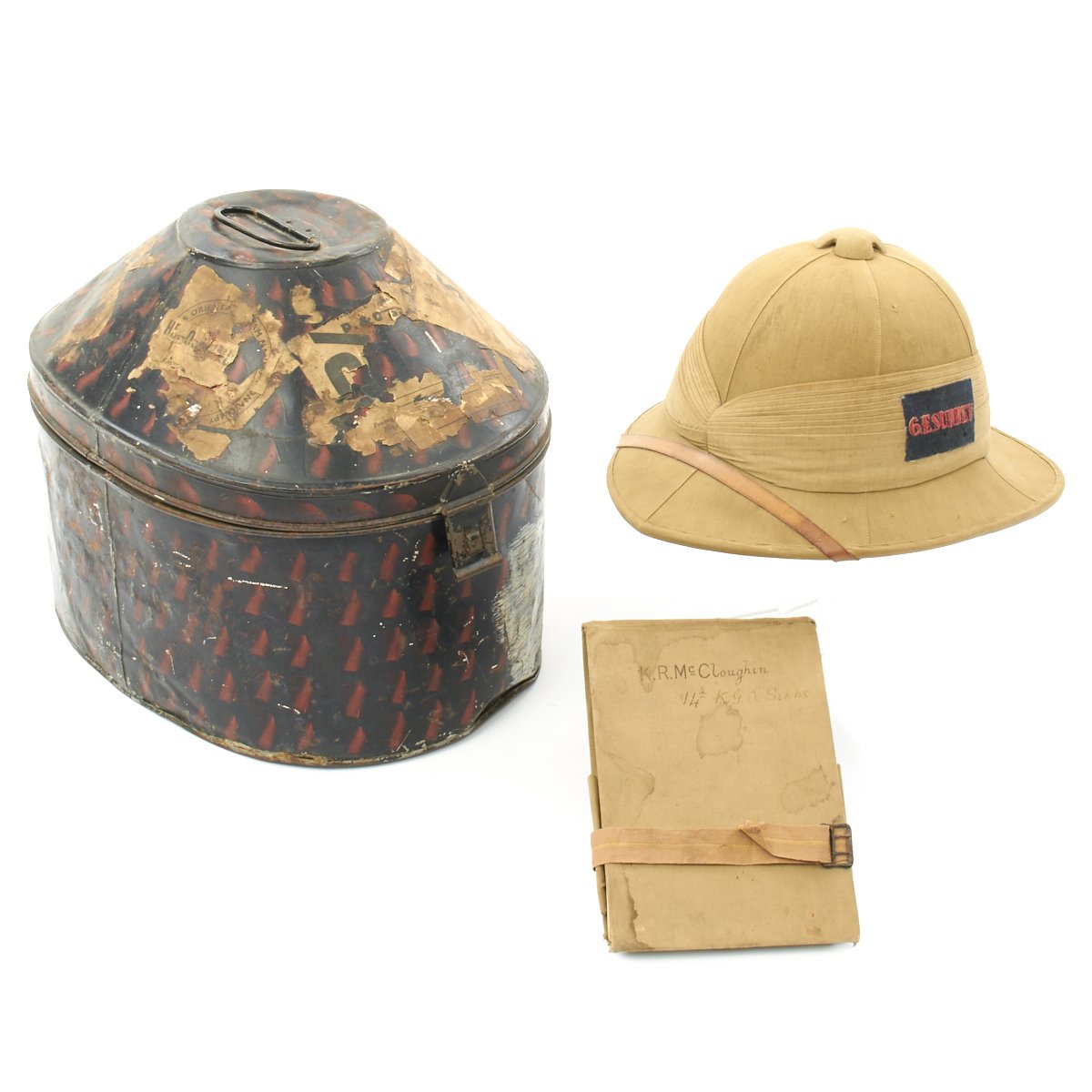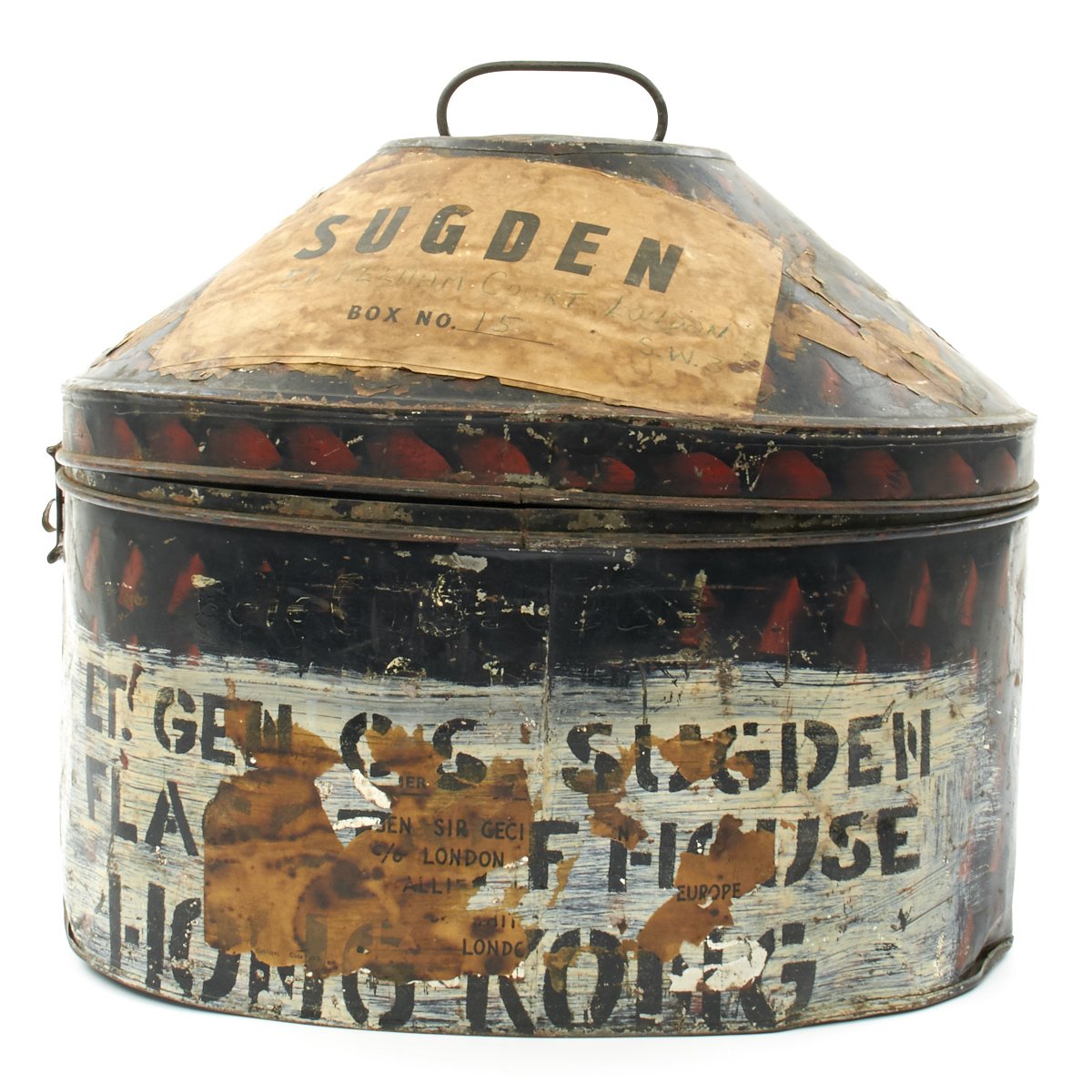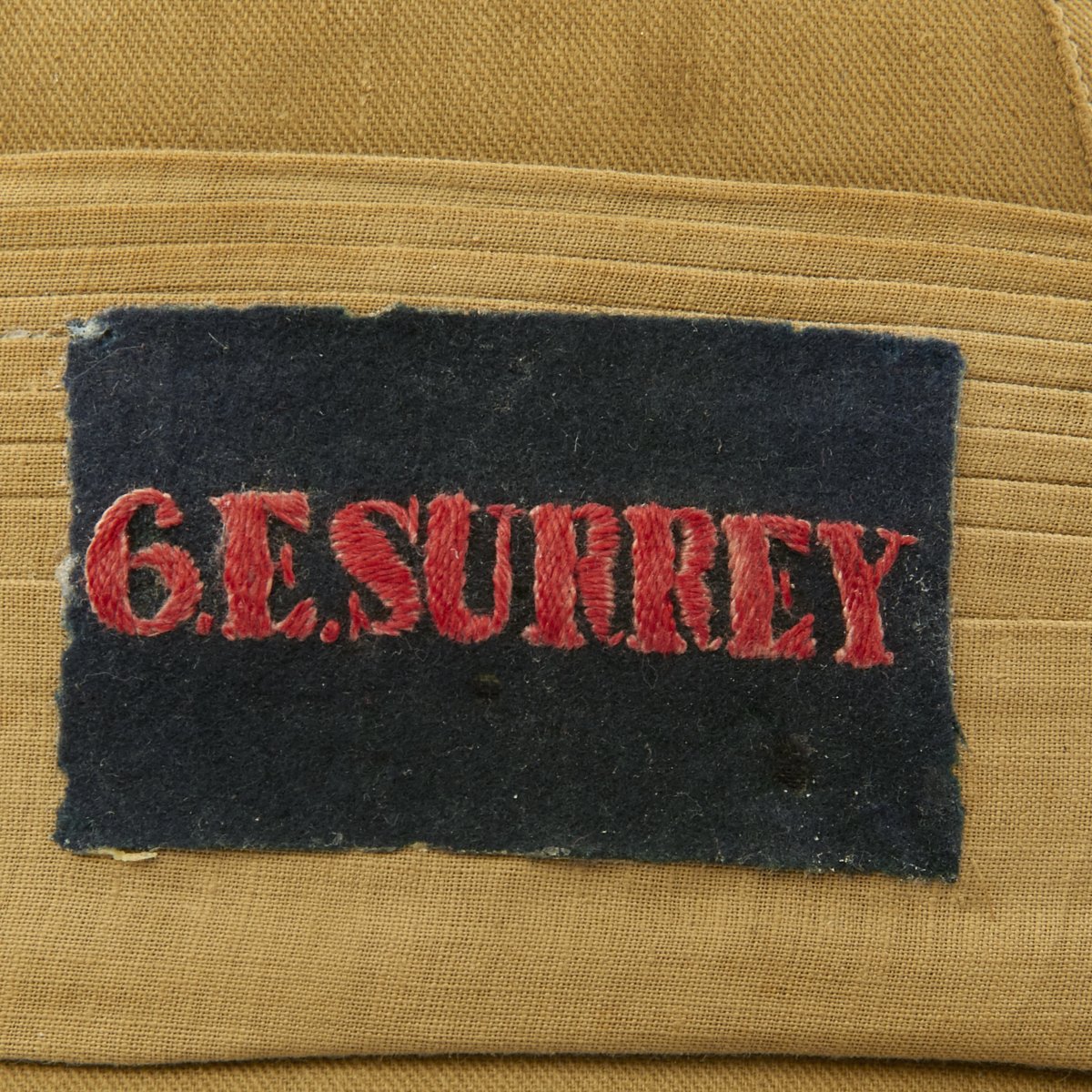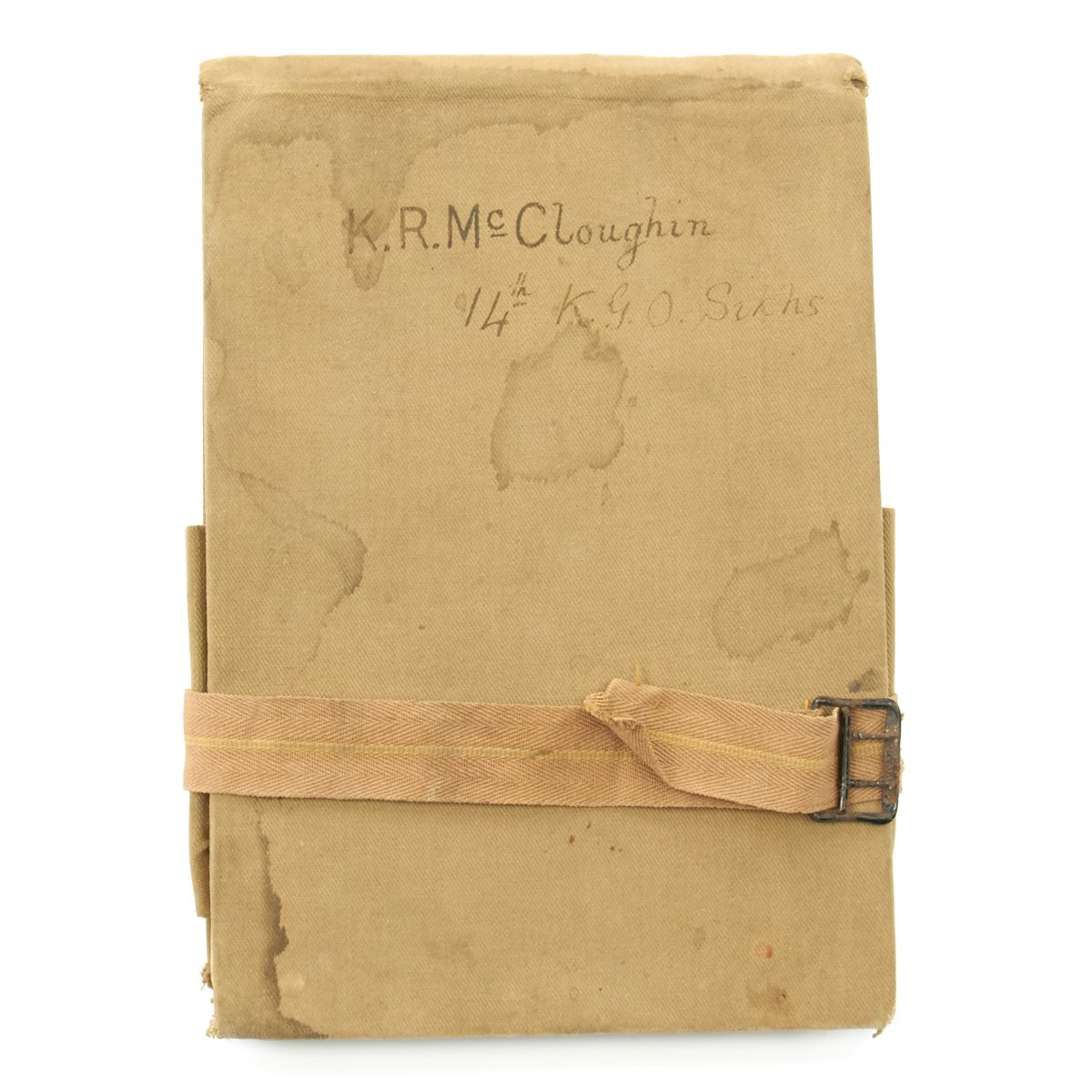Original British WWI Sun Helmet of Brigadier-General Richard Edgar Sugden with Orders Notebook Original Items
$ 1.295,00 $ 323,75
Original Item: One-of-a-kind. Brigadier-General Richard Edgar Sugden, CB, CMG, DSO & Bar, TD, DL, JP (21 August 1871 – 9 May 1951) was a British Army officer who was highly decorated for his service in the First World War.
After leaving school Sugden went into the family business. He was also a keen rugby player, and played for Yorkshire Rugby Football Union in 1895 and 1896.
In 1899 he volunteered for service with the Imperial Yeomanry, and saw active service in the Second Boer War with the 3rd Battalion in the Transvaal. During the conflict he received a commission as a lieutenant. After the war ended in June 1902, Sugden returned home with the other officers and men of his battalion in the SS Kinfauns Castle leaving Cape Town in early August 1902. He relinquished his commission the following month and was granted the honorary rank of Lieutenant in the Army. In 1904 he transferred to the 4th Battalion, Duke of Wellington’s Regiment, a unit of the Territorial Army.
Sugden was serving as the second-in-command of his battalion at the start of the First World War. He fought in the Second Battle of Ypres, and was wounded in September 1915. He returned to his regiment the following November. Sugden was awarded the Distinguished Service Order on 3 June 1916 and on 4 September 1916 he became Commanding Officer of the 4th Battalion DWR.[3] On 17 December 1917 he was awarded a Bar to his DSO. He was promoted to brigadier-general on 7 June 1918 and took command of the 151st Infantry Brigade. The brigade was engaged in action in France between October 1918 and the Armistice of 11 November 1918.
After the war, Sugden remained in the Territorial Army and commanded the 147th Infantry Brigade until his retirement in 1926. He was made a Companion of the Order of the Bath in the 1926 Birthday Honours. After retirement from the army he played an active role in Brighouse society, becoming a Justice of the Peace and serving as a Deputy Lieutenant of the West Riding of Yorkshire. He became Honorary Colonel of the 4th Battalion DWR in 1931.
Years of service: 1899-1926
Rank: Brigadier-General
Commands held:
4th Battalion, Duke of Wellington’s Regiment
151st Infantry Brigade
147th Infantry Brigade
Battles/wars:
Second Boer War
First World War
Awards:
Companion of the Order of the Bath
Companion of the Order of St Michael and St George
Distinguished Service Order and Bar
Territorial Decoration
Croix de guerre (France)
Included in the set are a fantastic high quality Sun Pith helmet. The helmet features and embroidered patch to the left side that reads 6. E. SURREY in red thread mounted on a dark blue wool background. The helmet is offered in excellent condition. The tin transit chest which is named SUGDEN with long address on the top, along with an Orient Express label. The side is named to Lt. General Sugden with an address in Hong Kong. Also included is an Operation Orders Book detailing troop movements and orders of the 14th K.G.O Sikhs.
The 14th King George’s Own Ferozepore Sikhs was a regiment of the British Indian Army; they can trace their origins to the Regiment of Ferozepore formed in 1846. The regiment had a number of different titles over the following years: the 14th Bengal Native Infantry 1861–1864, the 14th (The Ferozepore) Regiment of Bengal Native Infantry 1864–1885, the 14th Regiment of Bengal Native Infantry (Ferozepore Sikhs) 1885–1901, the 14th (Ferozepore) Sikh Infantry 1901–1903 and finally, after the Kitchener reforms of the Indian Army in 1903, the 14th Ferozepore Sikhs.
The regiment was part of the international force compiled in China to fight the Boxer Rebellion 1900, and left China two years later.
Further changes in name followed: the 14th Prince of Wales’s Own Ferozepore Sikhs 1906–1910, the 14th King George’s Own Ferozepore Sikhs 1910–1922. To honor the visit of the Prince and Princess of Wales to Indian they took part in the Rawalpindi Parade 1905.
In World War I they took part in the Gallipoli Campaign with the 29th Indian Brigade and the Mesopotamia Campaign with the 51st Indian Brigade, 17th Indian Division.
In the post World War I reforms of the Indian Army they were amalgamated into a large regiment and became the 1st Battalion 11th Sikh Regiment. After the independence of India the regiment was allocated to the present-day Indian Army.
Overall a fantastic set belonging to a high ranking officer in the British Army before and during the Great War.
Fast Shipping with Professional Packaging
Thanks to our longstanding association with UPS FedEx DHL, and other major international carriers, we are able to provide a range of shipping options. Our warehouse staff is expertly trained and will wrap your products according to our exact and precise specifications. Prior to shipping, your goods will be thoroughly examined and securely secured. We ship to thousands clients each day across multiple countries. This shows how we're dedicated to be the largest retailer on the internet. Warehouses and distribution centres can be located throughout Europe as well as the USA.
Note: Orders with more than one item will be assigned a processing date depending on the item.
Before shipping before shipping, we'll conduct a thorough inspection of the items you have ordered. Today, the majority of orders will be delivered within 48 hours. The delivery time will be between 3-7 days.
Returns
The stock is dynamic and we cannot completely manage it because multiple stakeholders are involved, including our factory and warehouse. So the actual stock may alter at any time. It's possible that you may not receive your order once the order has been made.
Our policy is valid for a period of 30 days. If you don't receive the product within 30 days, we are not able to issue a refund or an exchange.
You can only return an item if it is unused and in the same state as the day you received it. You must have the item in its original packaging.
Related products
Uncategorized
Uncategorized
Uncategorized
Uncategorized
Uncategorized
Uncategorized
Uncategorized
Uncategorized
Uncategorized
Uncategorized
Uncategorized
Uncategorized
Uncategorized
Uncategorized
Uncategorized
Uncategorized
Uncategorized
Angolan Rebel 1970s era 60mm Inert Display Mortar from Angolan Civil War Original Items
Uncategorized
Uncategorized
Uncategorized













































































